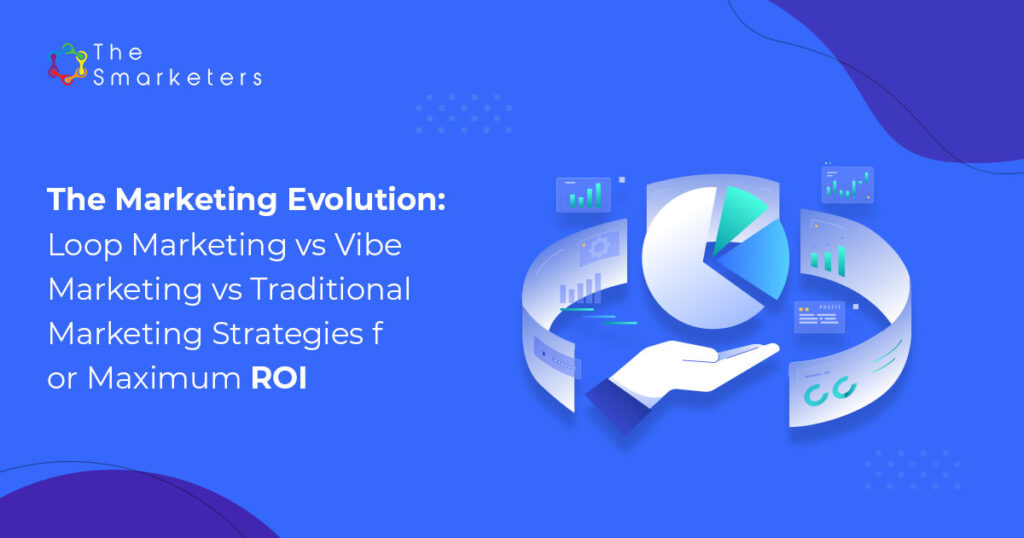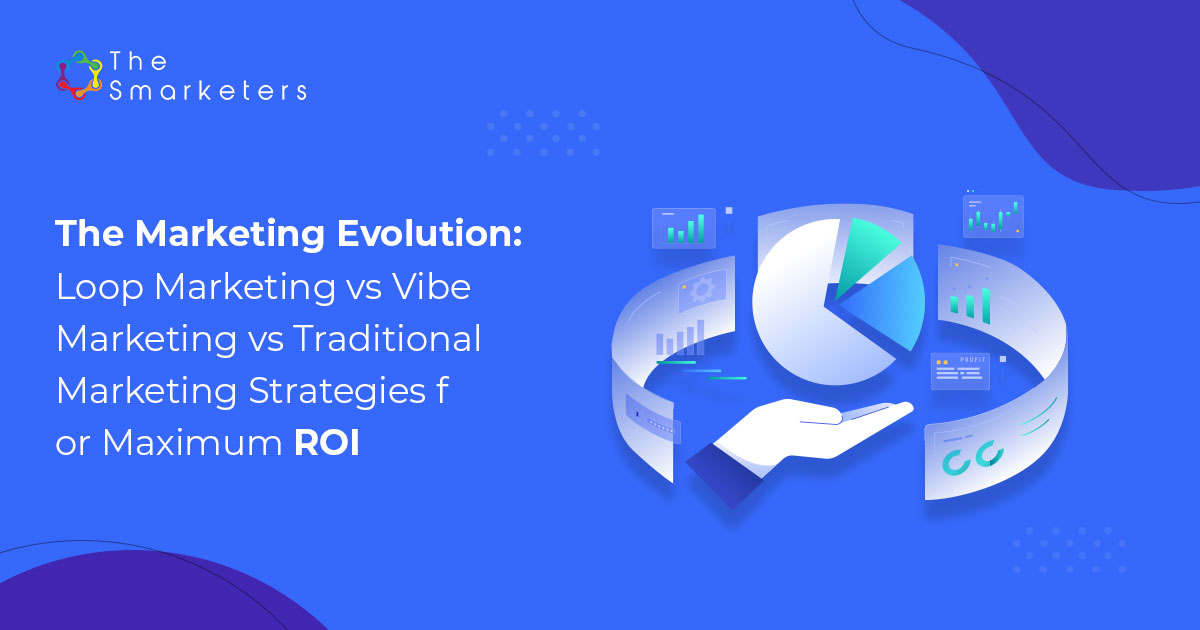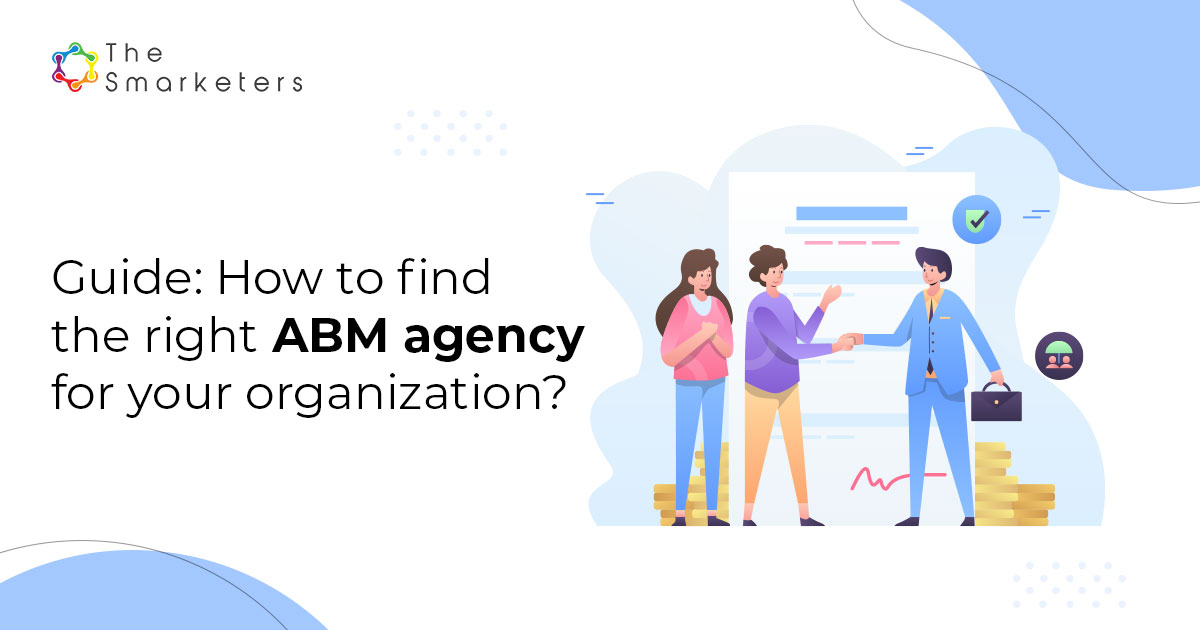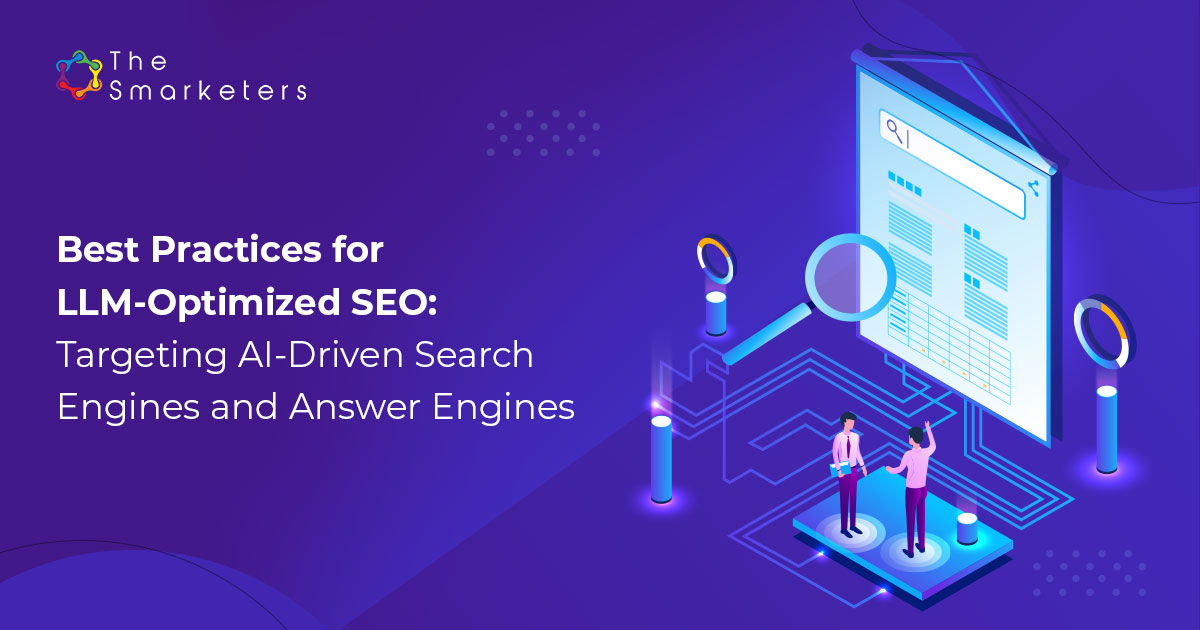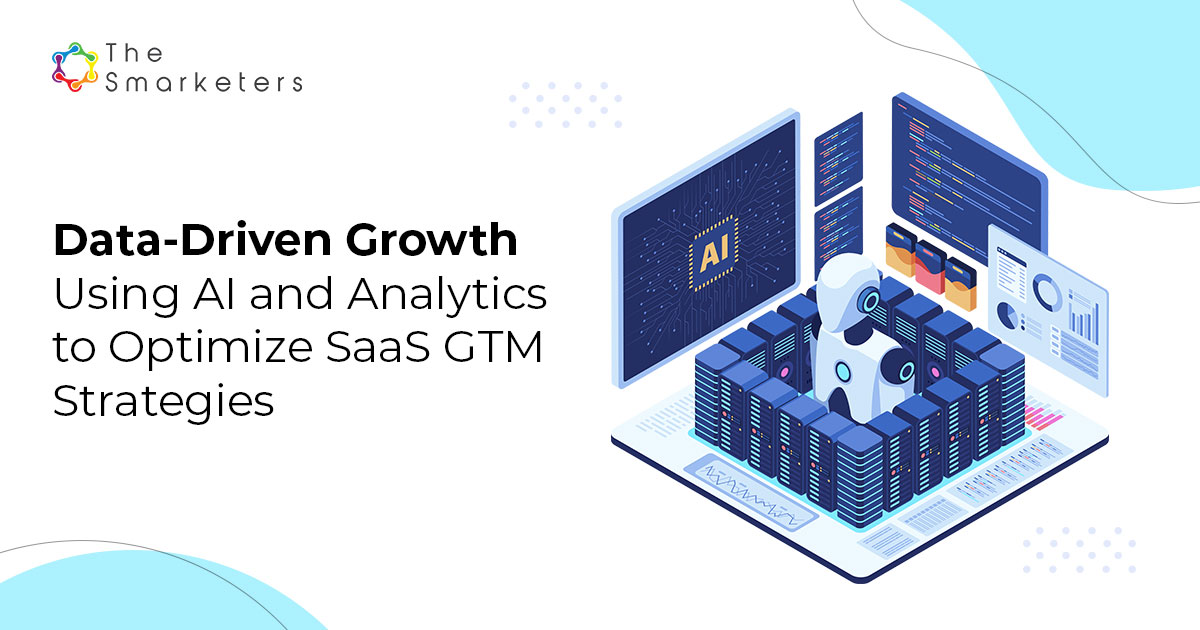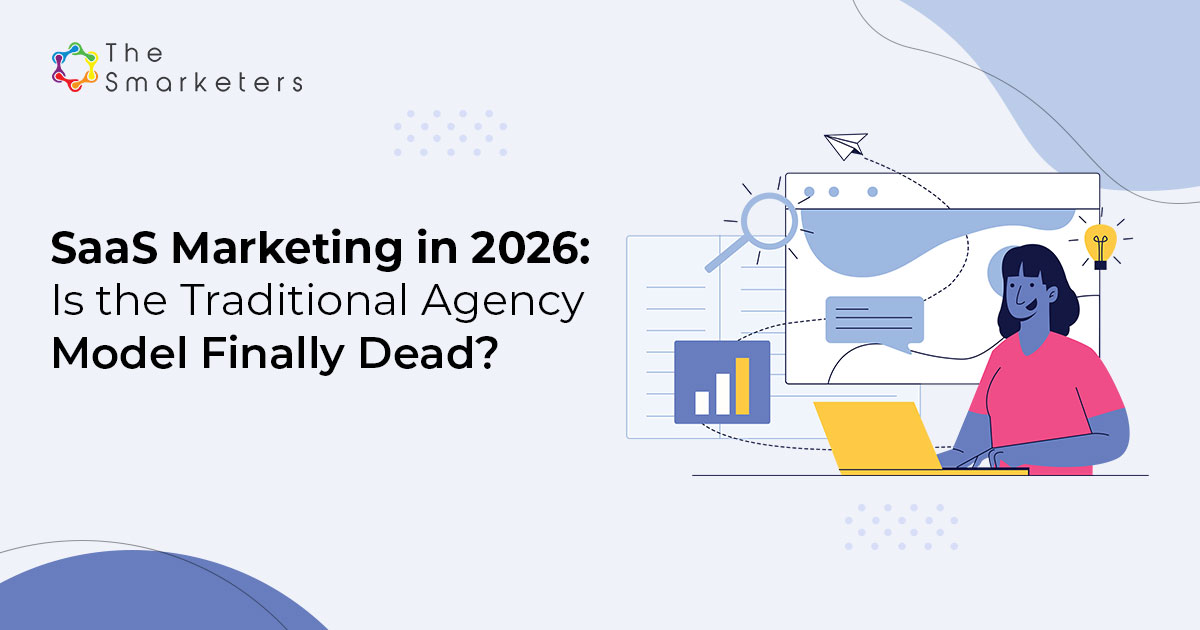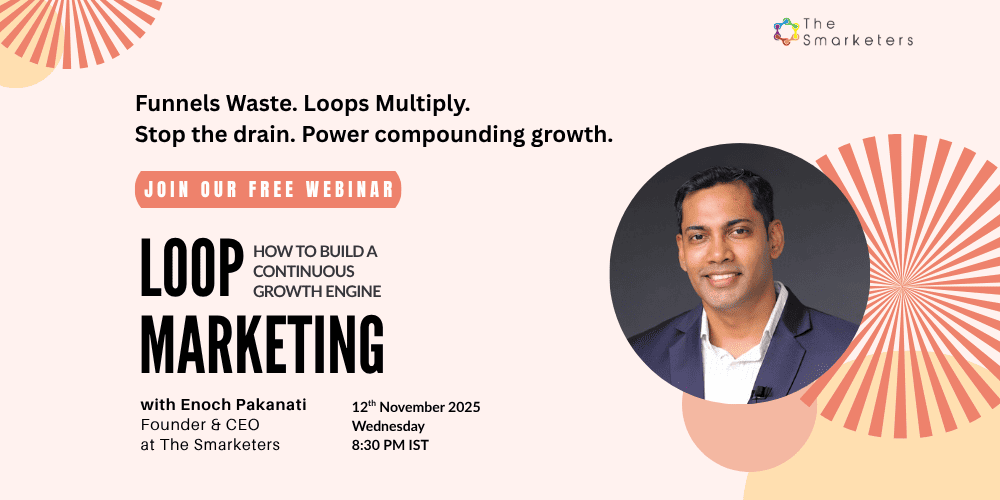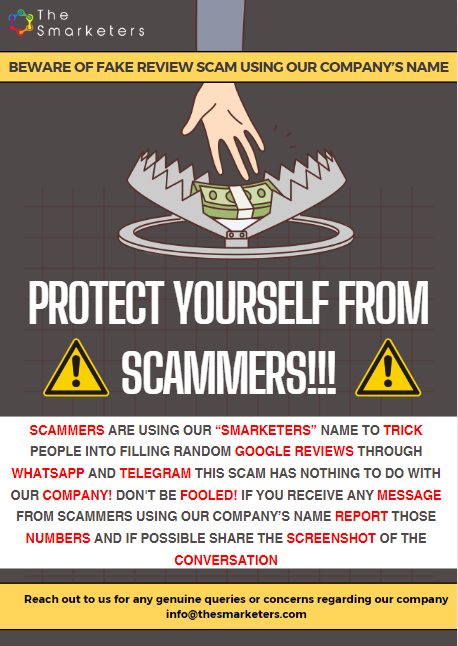Table of Contents
- Why Traditional Marketing Still Matters (But Isn't Enough)
- Loop Marketing: The Compounding Growth System
- A Real-World Loop in Action
- Vibe Marketing: The Emotional Accelerant
- The Content Bridge: Why Long-Form Still Wins
- The Strategic Integration: How to Combine All Three
- The Metrics That Actually Matter
- Why Most Brands Fail at This (And How to Avoid It)
- How Smarketers Help Brands Build These Systems
- FAQs
- The Bottom Line
- Guide: How to find the right ABM agency for your organization?
- Data-Driven Growth: Using AI and Analytics to Optimize SaaS GTM Strategies
- Beyond the Buzz : How ABM AI Integration is Redefining B2B Marketing in 2025
- Mapping Your Customer Journey with AI – The Results Will Change How You Think About Marketing Forever
- 5 Areas Where B2B Data Can Make a Significant Impact on Your Business
Why Traditional Marketing Still Matters (But Isn't Enough)
Traditional marketing—your TV spots, print ads, event sponsorships, and billboard campaigns—isn't dead. It's just no longer sufficient on its own.
What it does well:
- Builds mass awareness fast
- Establishes brand legitimacy
- Reaches audiences who aren't chronically online
Where it falls short:
- You launch, wait, measure, then start over from zero
- Personalization is limited to broad demographics
- Feedback arrives too late to course-correct
- Attribution is muddy at best
The data backs this up. Digital channels consistently deliver higher measurable ROI than traditional ones [1], largely because they enable the one thing traditional marketing struggles with: real-time learning. This represents the core of marketing funnel evolution.
Traditional marketing isn't wrong—it's just incomplete. Think of it as the foundation, not the entire building.
Loop Marketing: The Compounding Growth System
Here's where things get interesting.
Loop Marketing flips the script on how campaigns work. Instead of launching something new every quarter, you build a self-improving system where each customer interaction feeds intelligence back into your marketing engine. These content loops in marketing create a continuous marketing engagement cycle powered by feedback-driven marketing principles.
The framework is elegantly simple:
1. Express — Define Your Brand Foundation
Start with clarity: who you are, what you stand for, and why it matters. This isn't fluff—it's the filter through which every piece of content and every campaign gets evaluated.
2. Tailor — Personalize Using Unified Data
Here's where the loop begins. Every email open, every page visit, every form fill feeds into a unified customer profile. Marketing automation and AI analyze patterns and predict what each segment needs next, creating personalized customer journeys through what we call the AI marketing loop.
Why this matters: Over 80% of buyers now complete most of their research before ever talking to sales [2]. If you're not personalizing the journey, you're invisible during the decision phase.
3. Amplify — Distribute Strategically
Multi-channel distribution isn't about being everywhere—it's about being in the right places at the right time with the right message. Your data tells you where your audience actually engages.
4. Evolve — Analyze, Iterate, Improve
This is the closing of the loop. Every campaign generates data. That data informs the next iteration. Rinse and repeat.
The compounding effect: Companies using data-driven marketing achieve 5–8× higher ROI than those relying on intuition alone [3]. But here's the kicker—that multiplier grows with each cycle because your system gets smarter.
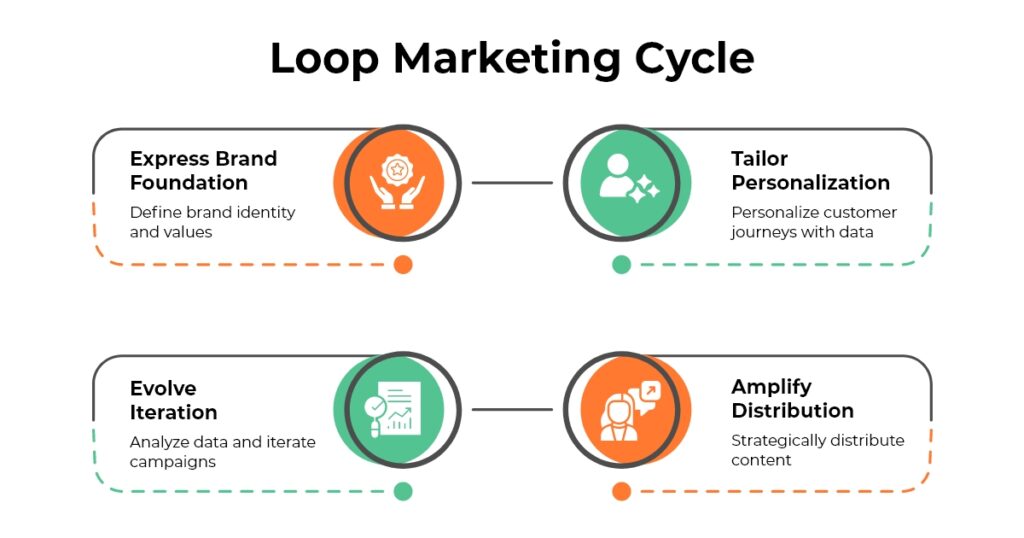
A Real-World Loop in Action
Let's make this concrete.
Imagine you're a B2B SaaS company selling project management software.
Cycle 1:
- You launch an educational email series on "remote team productivity"
- You track which topics get the highest open rates (turns out it's "async communication")
- You see that people who read 3+ articles are 4× more likely to book a demo
Cycle 2:
- You create more content around async communication
- You build an automation: anyone who reads 3 articles gets a personalized demo offer
- You A/B test subject lines and find "practical" outperforms "innovative"
Cycle 3:
- You expand into LinkedIn with async communication themes
- You retarget engaged readers with case studies
- You notice C-level titles prefer video content, while managers prefer written guides
Within three cycles, you've moved from generic outreach to a precision-targeted system that knows:
- What topics resonate
- What content format does each segment prefer
- When they're ready to convert
- How to automatically nurture them there
That's Loop Marketing. Each cycle makes the next one more effective through predictive content cycles that anticipate customer needs.
Vibe Marketing: The Emotional Accelerant
Now, let's talk about the layer that makes all of this feel right.
Vibe Marketing isn't about abandoning data—it's about using data to understand what emotionally resonates, then amplifying that feeling across every touchpoint. It's an emotion-based engagement model powered by customer resonance AI that tracks consumer behavior marketing trends in real-time.
Interest in Vibe Marketing has surged 686% in the past 12 months [4]. Why? Because in markets where products are increasingly similar, emotional connection becomes the differentiator.
What Vibe Marketing Actually Looks Like
It's not just "having a personality" or "posting memes." It's strategic emotional resonance:
Example 1: Duolingo - They turned a language learning app into a cultural phenomenon by leaning into their mascot's unhinged personality. The product didn't change—the vibe did. Result: 89.5M active users and a brand people actively want to engage with.
Example 2: Liquid Death - They sell water. Literally just water in a can. But they positioned it with extreme sports, heavy metal aesthetic, and punk rock attitude. The vibe transformed a commodity into a movement.
The Three Pillars of Effective Vibe Marketing
- Cultural Awareness — You're not creating the vibe; you're identifying and amplifying what already resonates with your audience
- Consistent Tone — Every piece of content reinforces the same emotional territory (even when topics vary)
- AI-Powered Adaptation — Use narrative-driven marketing AI to test variations faster and identify which emotional angles drive engagement
Critical distinction: Vibe Marketing without Loop Marketing is just branding. Vibe Marketing within Loop Marketing becomes a measurable growth lever because you're testing, learning, and iterating on emotional resonance just like you do with targeting and timing. This is especially powerful in AI in B2B marketing applications.
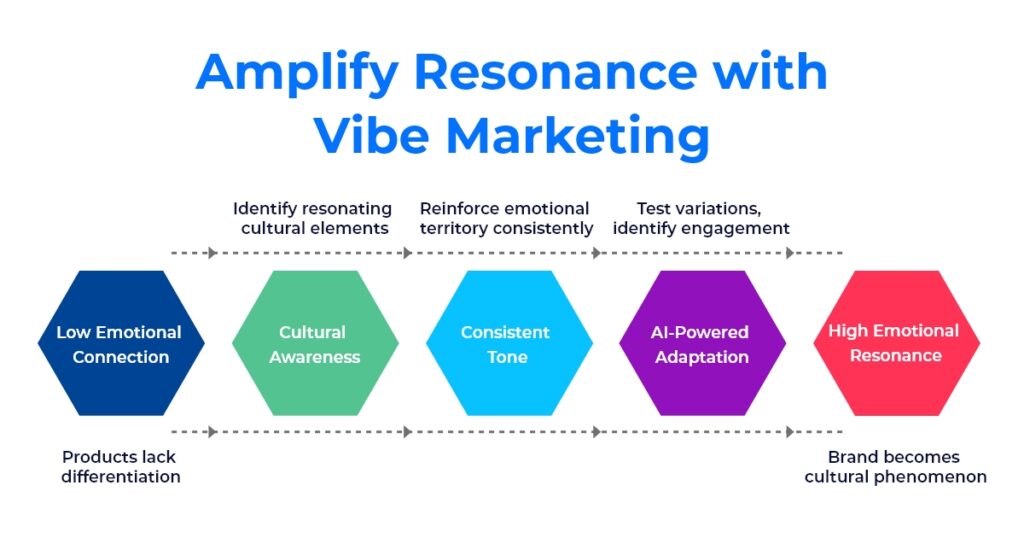
The Content Bridge: Why Long-Form Still Wins
Here's something most marketers miss: both Loop and Vibe Marketing need fuel—and that fuel is substantive long-form marketing content.
Articles over 3,000 words earn 77% more backlinks [5]. Why? Because comprehensive long-form storytelling:
- Establishes genuine expertise
- Answers multiple related questions
- Creates more engagement surface area
- Builds trust over time
68% of marketers increased their long-form output last year [6], but most are still treating it like traditional content—publish and pray.
The loop approach to long-form:
- Create in-depth pillar content around core topics
- Track which sections get the most engagement
- Break high-performing sections into social snippets and short-form content
- Use that distributed content to drive traffic back to the pillar
- Analyze the journey and optimize for conversion paths
Your 3,000-word guide isn't just an SEO play—it's the hub of an entire content ecosystem that loops prospects through your brand world. Modern B2B content personalization LLM tools enable generative marketing strategy approaches that scale this across thousands of customer segments.
The Strategic Integration: How to Combine All Three
When evaluating comparative marketing strategies, most brands make one of two mistakes:
- They try to do everything at once and execute nothing well
- They pick one approach and ignore the rest
The winning strategy is sequential layering:
Phase 1: Build Your Loop Foundation (Months 1-3)
- Audit your current data infrastructure
- Implement marketing automation (HubSpot, Marketo, or similar)
- Define key metrics: CAC, LTV, retention rate, engagement cycles
- Create basic content for each funnel stage
- Set up feedback mechanisms
Phase 2: Add Vibe and Emotion (Months 3-6)
- Analyze which content already resonates emotionally
- Define your brand's emotional territory
- Test different tones and narrative styles
- Identify your "vibe moments" in the customer journey
- Use AI tools to scale emotional testing
Phase 3: Layer in Traditional for Reach (Months 6-9)
- Use your loop data to inform traditional campaigns
- Deploy traditional tactics to drive volume into your loop
- Measure how traditional channels feed loop performance
- Optimize traditional spend based on loop insights
Phase 4: Optimize the System (Months 9-12)
- Identify which channels feed your highest-value loops
- Double down on vibe elements that drive retention
- Kill campaigns that don't feed the flywheel
- Document your playbook for scaling
The result: You're not running disconnected campaigns. You're operating a self-improving marketing system where traditional builds awareness, loop builds relationships, and vibe builds loyalty—all reinforcing each other.
The Metrics That Actually Matter
Stop obsessing over vanity metrics. In a loop system, you track:
Loop Health Metrics:
- Time to feedback (how quickly you learn from campaigns)
- Iteration velocity (how fast you can test and deploy improvements)
- Cohort improvement rate (Is each customer group performing better than the last?)
- Loop completion rate (what % of prospects complete your engagement cycle?)
Vibe Performance Metrics:
- Emotional engagement (comments, shares, saves vs. passive views)
- Brand search lift (are people actively seeking you out?)
- Community growth rate (are you building an audience or just renting attention?)
- Content resonance score (engagement time × sharing rate)
Integrated ROI Metrics:
- LTV: CAC ratio (aim for 3:1 minimum)
- Payback period (getting shorter with each loop cycle?)
- Revenue per content piece (which assets actually drive business?)
- System ROI (total output divided by total marketing investment)
Traditional metrics like impressions and reach still matter—but only as inputs to the system, not outcomes.
Why Most Brands Fail at This (And How to Avoid It)
Failure Point #1: No Central Data System - You can't run a loop if your data is scattered across disconnected tools. Fix your tech stack first.
Failure Point #2: Treating Vibe as "Nice to Have" - Emotional connection drives retention. Retention drives LTV. LTV determines your acquisition budget. It's not optional.
Failure Point #3: Expecting Instant Results - Traditional campaigns peak fast. Loop systems compound slowly, then suddenly. Give it 6-9 months before judging.
Failure Point #4: Automation Without Strategy - Tools don't create strategy. They execute it. Get the framework right before you scale.
Failure Point #5: No Feedback Integration - If insights from Campaign 3 aren't actively improving Campaign 4, you don't have a loop—you just have sequential campaigns.
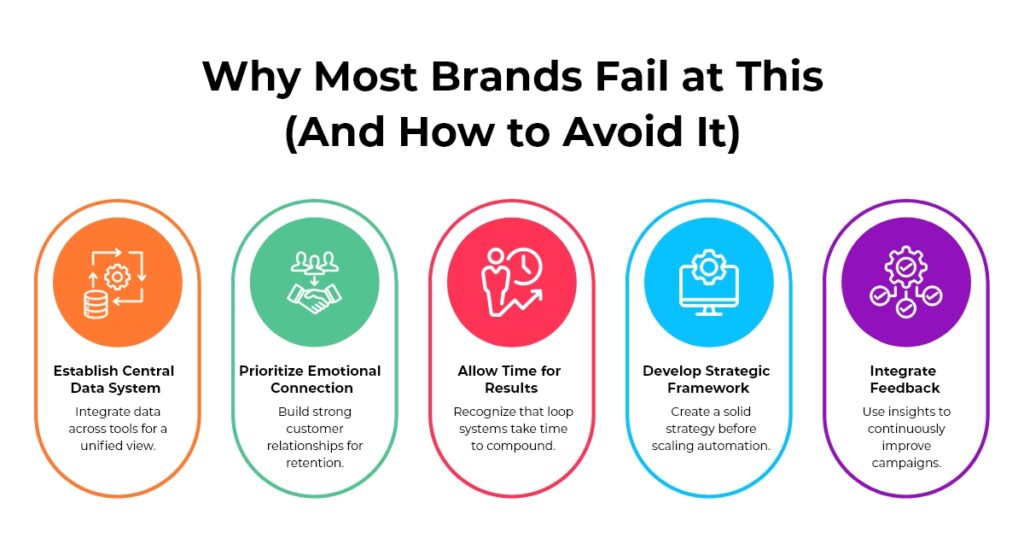
How Smarketers Help Brands Build These Systems
At Smarketers, we don't just execute campaigns—we build marketing systems that get smarter over time.
Our approach:
- Loop Architecture — We help you implement data-driven Loop Marketing systems using HubSpot automation and unified analytics, ensuring every campaign feeds intelligence into the next.
- Emotional Storytelling — We create long-form content assets that establish authority while incorporating Vibe Marketing principles that make your brand memorable and culturally relevant.
- AI-Powered Personalization — We deploy machine learning to optimize messaging, timing, and channel selection based on real behavioral data, not assumptions.
- Integrated Dashboards — We provide unified visibility across acquisition, engagement, retention, and revenue so you can see how the entire system performs, not just individual campaigns.
- Strategic Consultation — We help you phase in these approaches without disrupting current operations, building the foundation before scaling complexity.
The brands we work with don't just get better marketing—they get a compounding growth engine that improves quarter over quarter.
FAQs
- What is Loop Marketing, and how is it different from Traditional Marketing?
Ans 1. Loop Marketing is a continuous, feedback-driven approach where every customer interaction generates data that informs and improves future campaigns. Unlike Traditional Marketing, which follows a linear funnel (Awareness → Interest → Decision → Purchase) with campaigns that have clear start and end dates, Loop Marketing operates as a self-improving system. Traditional Marketing measures success after campaigns conclude, while Loop Marketing uses real-time data to optimize during execution. The key difference: Traditional Marketing starts from zero with each new campaign, whereas Loop Marketing compounds results—each cycle makes the next one more effective through learning and iteration.
- How can AI and automation enhance Loop Marketing strategies?
Ans 2. AI and marketing automation transform Loop Marketing from a manual process into a scalable, intelligent system. AI enables predictive content cycles by analyzing behavioral patterns to anticipate what content each segment needs next. Automation handles the execution—triggering personalized emails, adjusting ad targeting, and nurturing leads through customized journeys without manual intervention. The AI marketing loop works by: collecting data from every touchpoint, using machine learning to identify patterns and predict behaviors, automatically personalizing content delivery based on those predictions, and measuring results to refine future cycles. This creates what's called "customer resonance AI"—systems that learn which messages emotionally resonate with different audience segments and automatically optimize for those patterns at scale.
- Why is Vibe Marketing gaining attention among B2B brands?
Ans 3. Vibe Marketing has surged 686% in interest over the past 12 months because B2B buyers are fundamentally humans who make emotional decisions and justify them rationally . As B2B products become increasingly commoditized—where features and pricing are similar across competitors—emotional connection becomes the primary differentiator. Traditional B2B marketing focused on features, specs, and ROI calculators, but this clinical approach fails to create brand loyalty. Vibe Marketing in B2B contexts means developing a distinct brand personality, cultural relevance, and emotional territory that makes buyers feel aligned with your company's values and vision. AI in B2B marketing now enables rapid testing of different narrative approaches and emotional angles, allowing brands to identify what resonates without the slow, expensive testing cycles of the past. B2B brands with strong vibe—companies that feel human, culturally aware, and emotionally intelligent—consistently outperform competitors stuck in feature-first positioning.
- What are the measurable differences between Loop Marketing and Vibe Marketing in customer retention?
Ans 4. Loop Marketing and Vibe Marketing serve different but complementary retention functions. Loop Marketing improves retention through operational efficiency: it tracks engagement patterns, identifies at-risk customers through behavioral signals, and automatically triggers re-engagement campaigns. The measurable impact shows in metrics like: reduced churn rate (typically 15-30% improvement as cycles mature), increased customer lifetime value (LTV grows 5-8× when data-driven personalization is applied ), and improved retention cohorts (each customer group retained better than the previous one). Vibe Marketing, by contrast, improves retention through emotional loyalty. It's measured through: brand advocacy rates (how many customers actively recommend you), community engagement (participation in brand communities, events, UGC creation), organic search lift (are customers seeking you by name?), and retention even when competitors offer better pricing. The most effective approach layers both: Loop Marketing ensures you're operationally delivering value at the right time, while Vibe Marketing ensures customers feel emotionally connected to your brand identity. Together, they create "sticky" customers who stay both because the experience is optimized (Loop) and because they identify with your brand (Vibe). - How does content length and storytelling impact emotional branding in Vibe Marketing?
Ans 5. Long-form storytelling is the primary vehicle for building the emotional depth that Vibe Marketing requires. Short-form content can establish tone and personality, but long-form marketing content (articles over 3,000 words) builds trust, authority, and deep emotional connection . Here's why length matters: Time investment signals value—when readers spend 10-15 minutes with your content, they develop stronger brand recall and affinity, Narrative depth creates emotional arcs—long-form allows you to take readers on a journey with tension, insight, and resolution that short content can't achieve, Multiple touchpoints within one asset—a comprehensive article addresses multiple pain points, creating more opportunities for emotional resonance, Authority establishment—68% of marketers increased long-form output because it positions brands as thought leaders, not just vendors. In Vibe Marketing specifically, long-form storytelling lets you weave your brand's personality, values, and cultural awareness throughout the narrative rather than just stating them. The emotion-based engagement model thrives on stories that make readers feel understood, inspired, or validated—and those feelings require space to develop. Narrative-driven marketing AI can now help scale this by identifying which story elements, emotional beats, and content structures drive the strongest engagement, then using those patterns to inform future long-form creation.
The Bottom Line
Marketing is no longer about launching campaigns. It's about building systems.
Systems that learn from every interaction. Systems that compound results over time. Systems that blend data precision with emotional resonance.
Traditional marketing builds awareness. Loop Marketing builds momentum. Vibe Marketing builds loyalty.
Together, they create something greater than the sum of their parts: a marketing engine that gets more effective every day it runs.
The question isn't whether to evolve your approach. It's whether you'll do it before or after your competitors.

